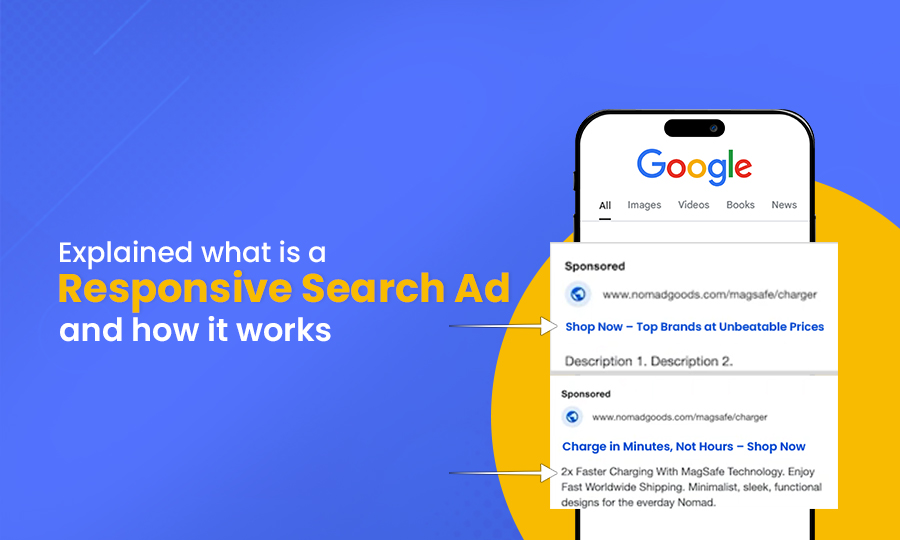Are your existing campaigns not delivering satisfactory results? It’s time to turn your heads towards responsive search ads (RSAs), which have tantalized the sense of the majority of marketers.
Launched a few years ago by Google, RSA is an ad format that prevents you from creating ad headlines and descriptions. Instead, you can allow Google Ads various options for mixing and matching, and thus algorithms produce the right ad combination for every eligible search.
This kind of flexibility works effectively for time-saving and also improves the ad’s importance. It of course makes a significant impact on increasing click-through rates and thus ensures a huge success of the campaign.
In this post, we will let you know the way to create a campaign and the right strategies that help you get the best performance.
What is a Responsive Search Ad?
As mentioned, RSA is a type of Google Ads with a different format. It can automatically adjust everything be it descriptions, headlines, or layout to match the user’s context. Rather than creating content on its own, Google picks from your provided descriptions and headlines to discover the most effective combinations.
For instance, if you are a café owner who seeks to advertise your services, you can send Google multiple headlines such as ‘Enjoy Fresh Coffee ‘, ‘Rejuvenate yourself with Rendezvous Atmosphere’, etc.
You need to include various descriptions related to your headline as well to highlight your current offers, coffee’s flavor, or the calm environment of the shop. After, this Google checks your provided headlines and descriptions with several combinations and displays the most relevant version based on users’ search queries.
Here’s the best example of RSA;

In the above ad, marketers focus on providing affordable pest control services and create headlines and descriptions accordingly.
How Does a Responsive Search Ad Function?
Responsive search ads leverage Google’s AI to combine both headlines and descriptions you offer. The entire system first analyzes the context of every search query and also implements real-time signals to select the most effective ad text. The major objective is to reflect the perfect ad to the right audience at the right time.
Let’s explore the way Google Ads creates responsive search ads;
- Google first checks every search query and relevant keywords.
- The system then picks and combines the right headline with the best matching description from the available options. While selecting, Google focuses on various important factors such as predicted performance and relevance.
- The system eliminates redundant or duplicate scores and combinations.
- The right combinations advance to the auction. This is where they compete for ad placement according to both relevance and quality.
- Google Ads chooses multiple headlines and descriptions in every ad. Certain ad text tends to appear in bold when it aligns perfectly with the search term of users. With time, Google Ads refines its understanding of the right ad combinations that perform outstandingly for a range of queries.
How Many Responsive Search Ads Does Google Permit?
As per Google, you can create a maximum of three RSAs for every ad group. If you think, three RSAs are not sufficient to cover everything you wish to promote in any ad group, you get two important options that are as follows;
- You should always reconsider your keyword lists and then convert them into small ad groups.
- It’s crucial to add dynamic search ad groups for your campaign.
How to Create a Responsive Search Ad?
Creating an RSA is a straightforward process that consists of multiple steps serving a specific purpose. Let’s discuss each step one by one that a professional PPC company follows;
- Create a New Campaign
You need to start the process of creating RSA by opening your Google Ads account first and create new responsive search ads. Once you do it, you need to tap the option ‘create a new campaign’.
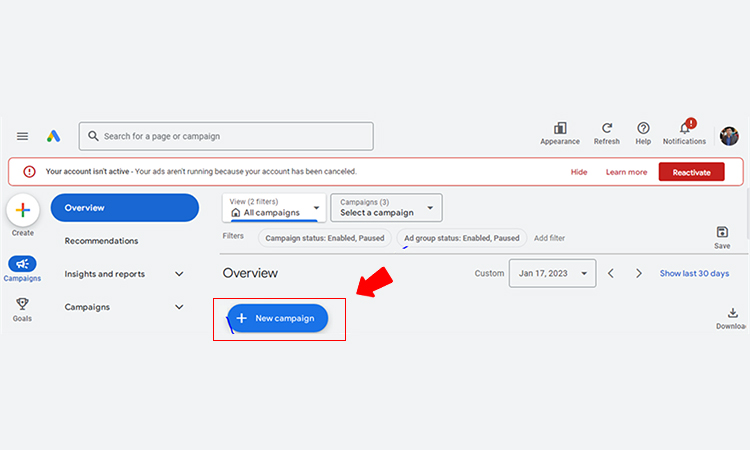
Once you hit the button ‘New Campaign’ you will now come across an option ‘Choose your Objective’. It asks about your primary goal of running the campaign. Whether you wish to generate leads, sales, or website traffic, you need to select your option accordingly.

However, you also get an option to create your campaign even without any objective.
Now, you will get an option ‘Select a Campaign Type’. Whether you wish to run a search, performance max, video, display, or shopping campaign, you need to mention the type of campaign clearly.

- Select the Right Bidding Strategy
Selection of the right bidding strategy is one of the important factors that determine the success of your campaign. You need to consider the primary metric while making a final selection. You need to decide whether you wish to focus on clicks or conversions.
The main reason is conversion tracking is quite necessary for leads, website traffic, sales, and other campaigns. Google Ads recommends the usage of a conversion-focused bidding strategy.
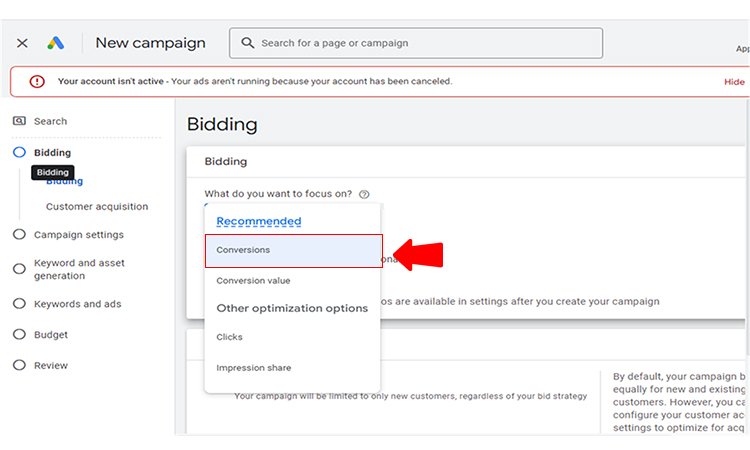
- Audience Targeting
Now, the next important option you get is ‘Audience Targeting’. It’s crucial to analyze Google Ads’ audience targeting option. It’s a good option to target searchers according to factors like language, location, timing, and more.
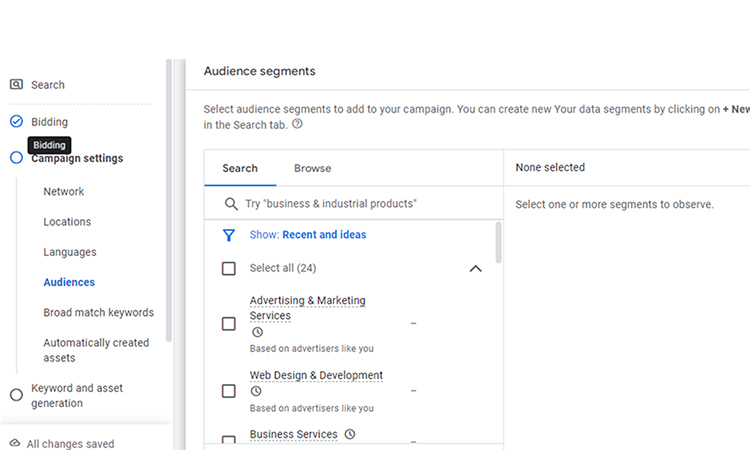
You can target various audience segments, whether it’s your first-party data, interest-based segments, or Ad affinity. Now the question is, is it necessary to target segments? Well, it depends on the situation.
You need to understand that audience segments are helpful for you to reach various specific groups of potential customers. Meanwhile, they should be limited, especially when your ads are appropriate to be visible. In case you add segments, you need to watch the estimated performance metrics of Google Ads to ensure the audience is large enough to reach your primary objectives.
- Enter your Targeted Keywords
While creating an ad group, you need to enter your targeted keywords. It’s important to use match types to target even more or less for specific searches. You can use the following important punctuation to add the best match types;
- Omit punctuation can be the right option to use broad match. It targets mainly searches related to your keyword.
- Add quotes is the best option to use phrase match. It targets searches that include the actual meaning of your keywords.
- You can ‘Add Brackets’ for an exact match. It helps you target searches with the same intent.
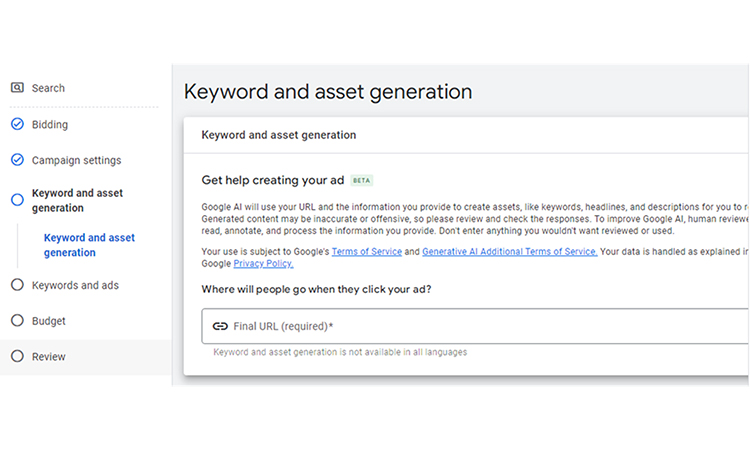
In case, you have a shortage of keywords, you can easily get suggestions for keywords. You will get an option to get relevant keyword suggestions just by entering the URL of your landing pages. Apart from the URL, you can also enter your services or products you wish to promote.
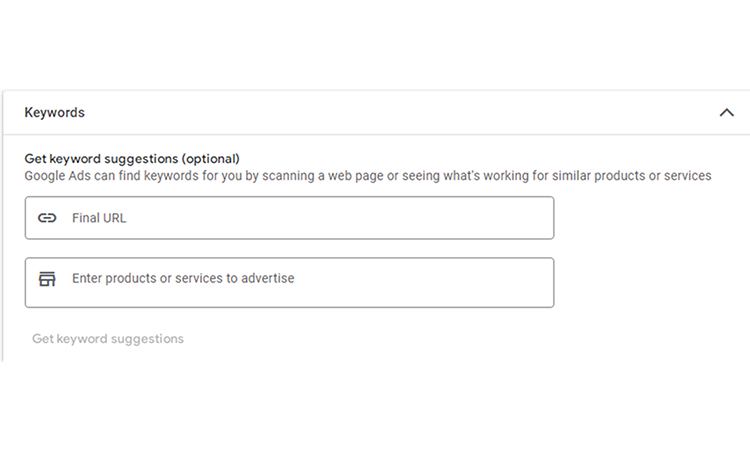
Once you get a complete list of relevant keywords, you should opt for relevant keywords. Enter the selected keywords for your new campaign.
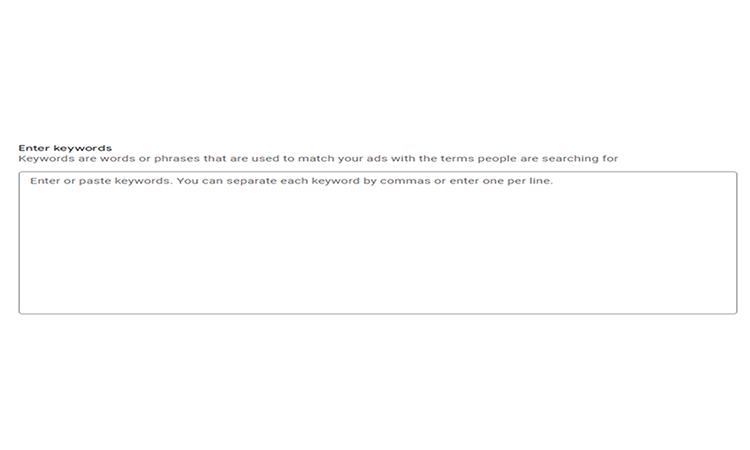
- Create a Responsive Search Ad
Now, this is the main step where you need to set up your campaign. For this, you need to enter the URL of your landing page, a minimum of two descriptions, a minimum of three headlines, and a display URL (optional).
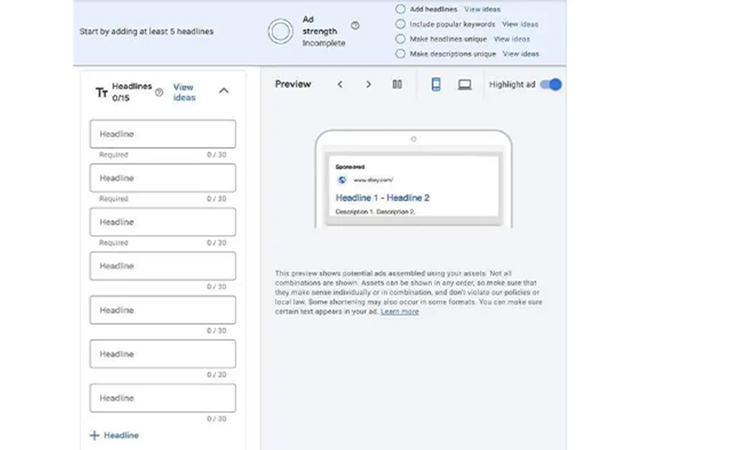
You can now click ‘View Ideas’ to analyze ‘Google Ads’ for any auto-generated suggestions. All you need to do is choose any of the copy suggestion options for adding them to the ad. You can customize them easily to fit your messaging, offer, and brand.
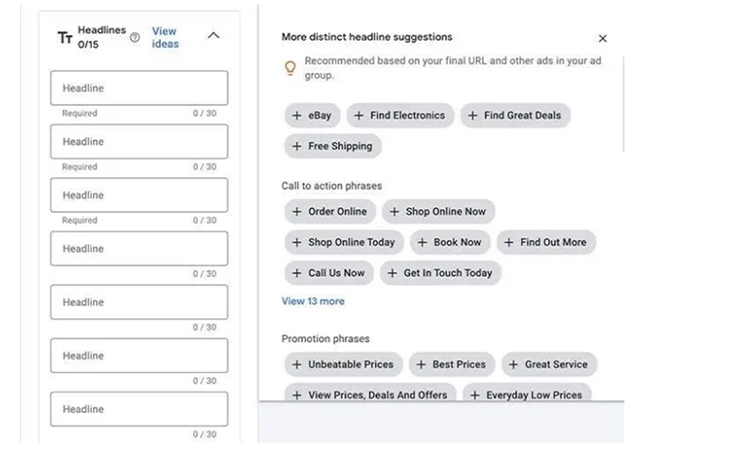
- Use Ad Extensions
Your RSA is incomplete without using Ad extension, which is also popular as an ad asset. Ad extension is useful in improving your Ad rank. It also determines where your search becomes visible in search engine result pages (SERPs).

Make sure you add relevant assets while creating Google responsive search ads. Following are the important elements you can include to make your ad most effective and conversion-oriented;
- Sitelinks are essential for searchers for additional options to click through your landing pages of websites.
- Callouts are essential to flag special offers or features.
- Structured snippets are essential to display types of products or brands.
- Image assets are essential to make your advertisement more visible in search results.
- Call assets are necessary to facilitate those of many potential customers to phone your business.
The most important thing is that you will face no limitations when it comes to enabling different ad extensions. Meanwhile, every asset type comes with varieties of options you can add.
Best Practices to Create a Responsive Search Ad
To make your responsive search ad more effective and conversion-oriented, you need to implement the latest industry practices. We discuss some of them in-depth. Let’s explore them now;
- Include Multiple Relevant Headlines and Descriptions
It’s advisable to provide many headlines and descriptions as much as possible while creating your ad. You need to understand that varieties of options let Google’s system test combinations and thus identify the most effective Ad options. Here’s the following important practices you can consider to implement;
- You will get an option to include up to 15 headlines and 4 descriptions. You are suggested to include 4 to 8 headlines and at least 3 descriptions.
- Every description and headline should match closely to meet the varied queries of customers. This kind of relevance improves performance. Google uses your assets to create ads while personalizing them to users.
- Make sure your every headline is standout. Google can reflect headlines in multiple orders.
- Flag Something Unique in Every Headline and Description
The next thing you can do is to match a variety of search queries. You need to indicate a variety of aspects of your products or services including benefits, features, and discounts. We discuss some important tips and tricks to help you create unique headlines for your RSA.
- You need to highlight various unique features or advantages that make you stand apart.
- You can write the same messages from different angles.
- You can also include a variety of aspects of your business, including service, quality, and ease of use.
- Make sure you vary your calls to action (CTAs) across different headlines. One CTA should encourage quick purchases whereas another could emphasize learning more.
- It’s crucial to highlight many unique features that competitors don’t provide.
- Never forget to mention special offers or discounts to focus on value.
- You need to use a variety of headlines and description lengths for higher flexibility.
- Avoid Using Keywords in Every Headline
Of course, keywords are highly important for any search campaigns. But, one thing you need to keep in mind is that every headline doesn’t require a keyword. Therefore, you need to always focus on engaging the audience with features, benefits, or also clear calls to action.
When you overuse keywords, it makes your ad text robotic. Rather than doing this, you can maintain a proper balance between audience-focused messages and keyword usage. Let’s uncover certain most effective tips and tricks;
- Communicate value by creating a headline as ‘Get Quick Delivery’ and Save Time’. It helps you highlight advantages even without depending on a keyword.
- Spotlight a feature by creating a headline like ‘Enlarge Images Up To 50P’. It shares a crucial product detail even without keyword repetition.
- Encourage Action by creating a headline like ‘Buy for Lucrative Discounts’. It acts as a perfect guide for users towards a particular next step.
- Address Requirements by creating a headline like ‘Personalized Diet Plan, Avail Now’. This appeals mainly to users looking for various customized solutions.
- Use High-Performing Static Ads
Make sure your successful static advertisement guides you better in creating a highly responsive search ad. The following are the most important steps;
- You need to first recognize those high-performing static ads by determining conversions, click-through rates, or also several KPIs.
- It’s crucial to analyze the advertisements for several elements that contribute actively to success, including compelling headlines, calls to action, or also clear descriptions.
- You need to extract several important phrases and messages that are more influential and thus also emphasize underlying value propositions.
- You need to convert these important elements into RSA descriptions and headlines. You can rewrite them for variety when it comes to preserving any important ideas.
- You need to form variations of every successful element with the use of synonyms, adjusting the focus, or also changing sentence structures.
- Determining the performance to analyze the RSA assets for resonating with your audience. You need to then refine and also optimize further.
It’s necessary to adapt those of many top-performing expanded text ads into Google responsive search ads. Google no longer permits the creation or also editing of various expanded text ads. Meanwhile, you can indeed implement the same strategy.
It’s crucial to take successful content and then transform it into RSA descriptions and headlines. You can implement these important recommendations to boost your Google Ads performance.
- Pin Descriptions and Headlines to a Specific Positions
You need to pin the most important content – it can be unique selling propositions (USPs), disclaimers, or more. It ensures your Google Ads displays them always. This strategy always works and makes your important messages visible in every impression and thus matches compliance or any branding requirements.
For instance, if you manage any vegan restaurant, you may use a headline, including “Pure Vegetarian Food.” You need to pin the same as a headline. Therefore, it reflects even if other headlines rotate perfectly.
You need to consider various important points when you pin your headlines and descriptions;
- Choosing the option ‘Displaying in any Unpinned Position’ gives you a surety that your message reflects. But, it may also be visible in different heading positions like 1, 2, or 3.
- You need to take into account that Headline 3 and Description 2 will not appear always. Therefore, any pinned messages in various positions will not always be part of any responsive search ad. You can pin headlines mainly for positions including Headline position 1 or 2, and also descriptions to Description 1 while ensuring its visibility.
- You need to pin a minimum of 2 or 3 headlines or descriptions for every position. This kind of approach is necessary to maximize variation. It minimizes potential performance drops as well.
- Removing or changing pinned headlines and descriptions tends to add to the visibility of your ad and also performance.
- Utilize Combination Rapport
With combination rapport, you will be able to get details of how asset pairings perform. You need to get an overview of the common asset combinations that allow you to visualize headlines and descriptions that perform well together.
The rapport reflects the right combinations and gets huge impressions. But, they don’t pin headlines or descriptions according to these metrics alone. Responsive search ads work perfectly when they adapt to various real-time signals including user preferences and search queries.
- Analyze Responsive Search Ads with Ad Strength
When it comes to ad strength, it provides insights, which reflect how perfectly your advertisement aligns with certain attributes correlated with improved performance. Its rating varies from ‘Poor’ to ‘Excellent’. It reflects how perfectly your campaign aligns with several performance indicators.
Let’s have a look at various components of ad strength;
Ratings
Its rating can be following to analyze the overall quality;
- Poor
- Average
- Good
- Excellent
Categories
It works effectively to examine many crucial factors such as uniqueness and number of headlines, distinct descriptions, and the use of appropriate keywords.
Ticker for Action Item
You need to suggest several specific improvements to enhance the effectiveness of the ad.
It’s a good idea to use Ad strength as a complete roadmap to redefine your responsive search ad. Your aim should be to get either an ‘Excellent’ or ‘Good’ rating based on recommendations and on-screen ideas. It’s something that involves modifying or adding descriptions or headlines.
Conclusion
A responsive search ad is an important type of Google ad. As we already discussed above, it’s based on using Machine Learning technology to automate the process of combining headlines and descriptions. Meanwhile, to create the most effective ads, you need to provide great inputs and also ongoing optimization.
A thorough and holistic approach is necessary to make your RSA result-driven. The above discussion will guide you to set up and run your campaign efficiently and get the desired outcomes. However, if you’re short on time or lack the necessary skills, hiring a professional google ads agency can help you maximize results and ensure your campaigns are handled effectively.
Additional Resources:
- SEO vs. Google Ads: Which Strategy Is Right for Your Business?
- What Are Google Local Service Ads and How Can They Boost Your Business?

